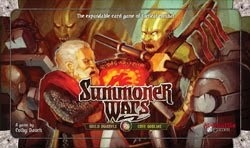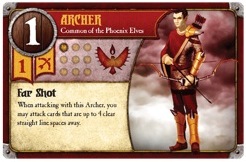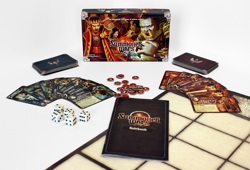
|
About OgreCave and its staff
|

|
by Lee Valentine
Summoner Wars, a fantasy-themed wargame, is the first release from new game company Plaid Hat Games. Colby Dauch, the founder of Plaid Hat, has previously made his name in the gaming industry by doing design and development work on Hasbro's Heroscape product line. Two different two-player starter deck products are currently available. One contains fire elves versus ice orcs, and the other product pits dwarves versus goblins.
Rules & Gameplay Like Battleground before it, Summoner Wars (SW) uses cards instead of miniatures. Unlike Battleground, SW is a tactical, skirmish wargame instead of an army-based, strategic wargame. SW is played on a rectangular grid/map rather than an open table like a more traditional miniatures wargame. All movement and distances in the game are measured orthogonally, either in straight lines or in zigzagging steps. Each map is designed for two players, and each player starts on one half of the map, in control of the warriors of a single race. Unlike more traditional wargames where most of your units start in play and are whittled away slowly, in SW your Summoner and a small selection of warriors is all that starts on the board. In a typical miniatures wargame, each player has a scenario-based objective or must destroy all of the opponent's units. The goal of SW is, however, more like taking the king in chess – if you capture the enemy Summoner then all of his cards leave play and he loses the game. Like Magic: The Gathering, the rest of the units you will summon are contained in a shuffled deck, with each player having his own deck. Also in your deck are various spell-like Event cards that let you spontaneously alter the contents of your hand or the current game environment. Each race has an unalterable and pre-determined starting configuration. In addition to your starting units, each side begins with a wall in play. Inexplicably, summoned units can only appear in empty grid spaces that are orthogonally adjacent to walls that you own, no matter how advantageous it may be to make them appear on some other space on the map. While walls block most ranged attacks, they primarily serve as obstacles to movement for both players, and as focal points to summon units around. The game has a relatively simple turn sequence, with each player taking his turn fully before his opponent may act. On a player's turn he: 1) draws 5 cards, Events cost nothing to play, but when a unit is summoned (other than those in your starting configuration), it usually must be paid for by discarding cards off the top of your Magic Pile. More powerful units cost more Magic. You don't reshuffle cards that you discard, and each player starts with less than 30 cards in his deck after setup. Thankfully you have another source of magic – each enemy unit that you kill is placed on top of your Magic Pile.
Each unit in the game has some game text on it, providing some diversity to each race. Players also have three more expensive units called Champions that tend to be somewhat more durable and more powerful. A player's Event selections are pre-determined by his race and are unalterable. Oddly, at least in two-player play, common units are frequently so ephemeral that much of the time it is all but impossible to engage in any long-term planning involving them: much of SW is purely moment-to-moment tactical play. Champions can alter this general rule, as some are quite sturdy. Oddly enough, and this was not obvious to me to begin with, each player usually has two major strategic decisions in the game: the placement of his two extra walls. Walls can only be placed on your half of the map. Most can take nine wounds, making them fairly permanent structures against any race except the Dwarves (who have special powers to destroy walls). Walls fully block most forms of movement. Since the game is bounded to a fixed grid, it's often difficult to maneuver around them. Since you can't move through other cards, the center of the board can occasionally become congested if players are on the defensive. This combination of factors, combined with the orthogonal movement restrictions, sometimes really limits movement more in SW than in any other wargame that I've ever played. In two-player play I felt that most of the decision-making was very light. The exception to this is the placement of walls, which can make or break your entire game. Orcs, who can summon several less durable Ice Walls using Events, make more of these decisions than other races. While I found that there were few other deep, on-board decisions of consequence, managing your Magic Pile is a skill that I'm sure separates the mediocre Summoner Wars player from the good one. This is true because in certain situations it's unclear whether you should discard 5 or 6 common units to your Magic Pile to summon one Champion. Even with those decisions included, the two-player version of Summoner Wars will primarily be of interest to casual gamers. Between drawing cards and rolling dice, there is quite a bit of luck in the game, but the "canned" starting configuration serves to mitigate this somewhat. All that being true, the two-player game is fairly balanced to allow equal chance of victory for each deck. Sometimes early in a long game I can tell who will win. One game I played lasted over an hour, and I knew I was going to lose early on (due to some bad luck on my part and great luck for my opponent); what followed was a 40+ minute death spiral. At other times the luck element will allow you to make a huge comeback. Regardless, if you make a tactical blunder like putting a fragile Summoner too close to an enemy wall, your game can be over in mere minutes.
Rules Differences for Four-Player Play Four-player play has some different features that add substantially to strategic options. First, it is played on two side-by-side maps. Instead of summoning units and playing walls only on your half of one map, you can play walls anywhere on your team's half of either adjacent map. While you can still only summon Units adjacent to your own walls, your walls can be created far apart from each other, allowing you the option of fortifying your own position or helping out your teammate. Units are not always summoned right next to each other, and so they can last slightly longer and give you the option to plan ahead a little more. Units can travel back and forth across the maps (as if they were one really large map). Additionally, reminiscent of some '80s video games, the left and right side of the board "wrap around", so units can leave on the left side of the left map and appear on the right edge of the right map. Attacks similarly wrap around, making ranged attacks very valuable, particularly against an unwary opponent. One of the biggest changes in the four-player game is that you can take cards out of your own Magic Pile and give them to your teammate. This makes it easy to summon up a much-needed Champion at a moment's notice, or to pay a cost to get out of some negative Event or another. This sharing of Magic Piles might make one Dwarven Champion abusable (I didn't play enough four-player games to absolutely determine this). Overall, however, I felt that this version of the game was pretty balanced. The two-player game is a casual game lasting around 30 minutes to an hour. The four-player game, however, is a much deeper, tenser game. It can last over two hours.
Deck Building
Rules Clarity While the templating on most of the game text is clear, tournament CCG players and rules lawyers may take issue with the precision of the text on a few cards. In a minority of cases the cards present a situation which is not explicitly covered in detail by the rules. For example, the designer has ruled online that a card called "Blaze Step" which teleports an Elvish warrior across the board, actually doesn't count as "moving" for effects which prevent movement. This very question has come up in two different online forums already. The rulebook offers little in the way of coverage of competing racial special abilities like this. Tournament CCG players will also note a lack of timing rules in spite of the fact that players can take actions on each other's turns. Plaid Hat has recently posted a FAQ, however, which will clear up most issues quite well.
Appearance, Components, & Packaging
The graphic design on the cards and the packaging is quite good. There was only one potential flaw with the layout of the cards – the summoning cost for the unit cards is right next to the symbol telling you whether the card can be used to attack at range. One player I played against intuitively saw a "1" and an arrow and thought that the card did one ranged damage, when the "1" was actually the summoning cost of the unit and it did 2 damage. Since I've seen a number of other games where a number and an arrow or bow would have been ranged combat damage, this type of misinterpretation of the card data could be frequent for novices. The art is stylized, without a lot of detail – it looks better in small sizes and looks a little rougher where an image is enlarged. While some of the art was merely serviceable, most of the art was good, particularly for an indie game company. The rulebook's graphic design and typography was attractive as well. The paper map is not printed in full-color and really is little more than an abstract grid with designated spots for various decks and piles. While the map doesn't always fold out perfectly flat during play, it is pretty sturdy and should stand up to repeated use.
Conclusions If you own both of the different starter sets for SW, however, then the four-player game becomes possible. With greater movement options, better strategic play, and the help of a teammate to balance out the luck in the game, the four-player game is a cut above the two-player game. While it doesn't have the visual awe of a full Heroscape Master Set or a game of Warhammer, the advantages of portability, low downtime during play, and quick setup will likely keep it in rotation for wargamers looking for something different.
For Retailers Lee's Ratings:
Overall: B+ (casual wargamers might rate this higher) Links
|
||||
 Summoner Wars
Summoner Wars When Moving units, you can move as many as three units per turn up to
two spaces each. Then you choose any three of your units to attack
with. Some units attack at range, but most are melee combatants.
Attacking is simple. Each unit has a Combat rating. You roll 1D6 for
each point of Combat Rating. Typically every roll of 3+ does one wound
to an enemy unit. Most common units can only take one or two wounds,
and many thus die the second someone breathes hard in their direction.
Given the starting locations of the walls, the two players are often
summoning warriors right next to each other. As a result, it is not
uncommon early in the game for one side to wipe out all of his
opponent's units except the enemy Summoner.
When Moving units, you can move as many as three units per turn up to
two spaces each. Then you choose any three of your units to attack
with. Some units attack at range, but most are melee combatants.
Attacking is simple. Each unit has a Combat rating. You roll 1D6 for
each point of Combat Rating. Typically every roll of 3+ does one wound
to an enemy unit. Most common units can only take one or two wounds,
and many thus die the second someone breathes hard in their direction.
Given the starting locations of the walls, the two players are often
summoning warriors right next to each other. As a result, it is not
uncommon early in the game for one side to wipe out all of his
opponent's units except the enemy Summoner.
 The cards themselves are roughly bridge-sized, and not the more common
poker-sized cards found in most CCGs (other than Yu-Gi-Oh!). While I
would have preferred a larger card size in principle, in practice Plaid
Hat chose the right size of card because the map is a reasonable size on
most tables. The press coat on the cards was a little thinner than on
Magic: The Gathering cards. Because of this, with the cards left
unsleeved, they started showing enough wear to mark some cards lightly
after several plays. They do have nice spring to them, and they shuffle
well. Each racial deck has a unique card back design to make them easy
to separate out if they are mixed together.
The cards themselves are roughly bridge-sized, and not the more common
poker-sized cards found in most CCGs (other than Yu-Gi-Oh!). While I
would have preferred a larger card size in principle, in practice Plaid
Hat chose the right size of card because the map is a reasonable size on
most tables. The press coat on the cards was a little thinner than on
Magic: The Gathering cards. Because of this, with the cards left
unsleeved, they started showing enough wear to mark some cards lightly
after several plays. They do have nice spring to them, and they shuffle
well. Each racial deck has a unique card back design to make them easy
to separate out if they are mixed together.